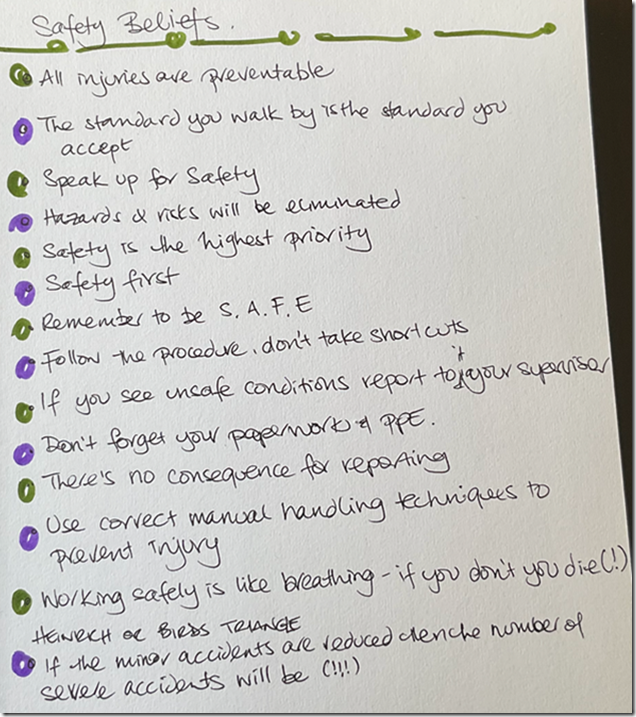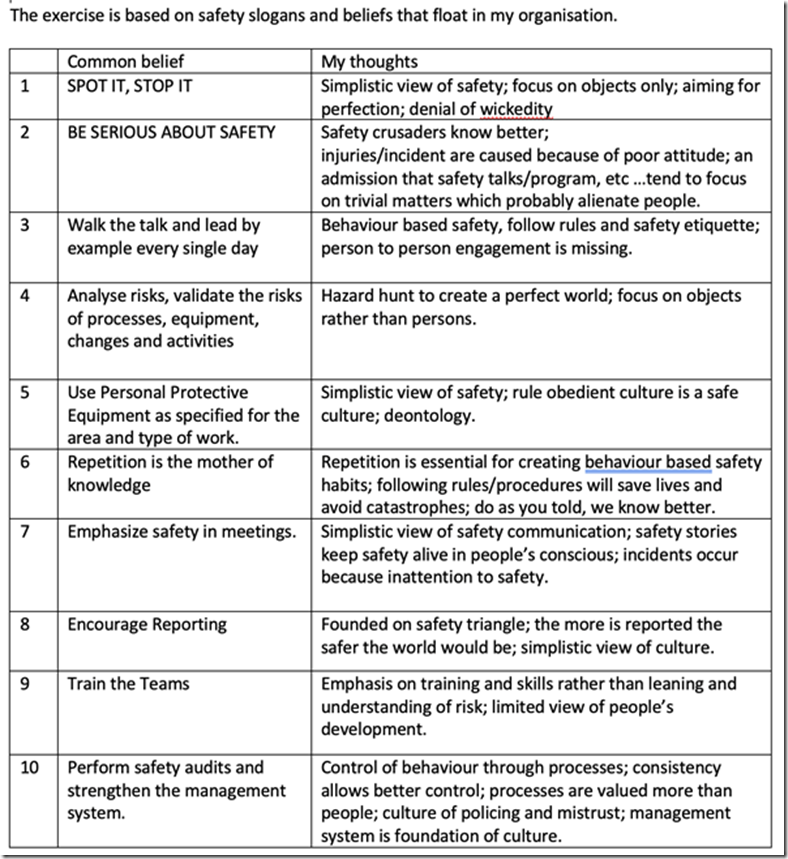I have group at the moment doing a free online workshop on culture and asked them to list 10 common safety beliefs:
- “Safety is a choice”. Belief or slogan? Choice of what? Decision based on good or bad. Very black and white
- “Safety never takes a holiday”. No wonder it has some may issues. Or is it a machine?
- “Swiss cheese model” my favourite, new people in the industry are so impressed by this. I suppose linear thinking is what we do around here haha.
- “Bradley Curve to Zero” I had the displeasure of the DuPont training circa 1995
- “No risk is acceptable” better not get out of bed that day
- “Safety First” hmm not really
- “less safe acts lead to unsafe conditions”
- “take 5 protects me”
- “checklist complete, work is safe”
- “all injuries are preventable”
- “Working safe is condition of employment”.
It appears belief can also make a slogan, Containing linear, behavioural suggestions
- Safety is a primary concern in every workplace.
- Treat all incidents seriously.
- Report any unsafe conditions.
- Never take shortcuts.
- Safety first.
- The rules are written in blood, but not MY blood.
- Someone other than me should be more concerned about my safety.
- Safety before production.
- Speak up.
- Zero harm.
- Cause-consequence equivalence.
- All incidents are preventable
- There is a root cause for every incident
- In the “green” of the risk matrix is an acceptable risk
- The last minute risk assessment will bring to the surface all we missed during preparation
- A certificate shows your capable of doing a certain job
- The more information I give people the better they are prepared (e.g. an induction)
- Zero is achievable
- If you follow procedures you will be safe
- Punishing people when not following golden rules will make it safer
- If they don’t follow your rules, tell them again, again, again that they have to follow the rules
This is my listing. I have divided them into what safety believes about itself, about others and about the world.
· Things that Safety Believe
· What they believe about themselves
· 1. They are infallible and that they have the only answers
· 2. Safety is about the application of common sense
· 3. In industry, Safety is as important as Production
· What they believe about others
· 4. There is a common sense and very easily discernible explanation for all human action
· 5. Humans are highly programmable
· 6. Behaviour is easily modified by training, signs and punishment and rewards
· What they believe about the world
· 7. All incidents are directly attributable to violations
· 8. There is a universal incident causation pathway that is linear – Swiss Cheese
· 9. Many minor incidents ultimately lead to fatalities – Heinrich Triangle
· 10. All incidents are avoidable – zero is just around the corner
1) That bad workers are usually the problem
2) Similarly, that workers need to be controlled to be fixed
3) That the ‘system’ is the ‘root cause’ of problems because it does not adequately control the workers
4) If something is not written down it does not exist – again a system problem
5) To improve a systemic process you just need to add more and clarify prescriptive requirements
6) That everyone interprets things (e.g., hazards, risks, convoluted requirements) the same
7) That on-site workers should exercise discretionary control of their work to improve efficiency but then blame them when they don’t follow the documented prescriptive requirements
8) That human decision-making is simple and deterministic – i.e., linear and not probabilistic
9) That compliance to regulations is the primary objective
10) That work can be done safely (i.e., without incidents) if people do what they are supposed to do.
11) That workers can be adequately trained to actually be competent in everything they are required to do.
Safety beliefs that spring to my mind include:
- There is such as thing as root causes.
- That risk is knowable.
- That all accidents can be prevented (whilst still remaining in business)
- That people follow procedures
- That adding an extra requirement to a procedure following an incident is an effective corrective action
- That CBT is an acceptable and effective way to train people
- That people make errors because the incentives are not appropriate.
- That KPIs represent the truth (spending hundreds of hours explaining statistically insignificant increase or reduction in performance with tenuous “successful” initiatives)
- That people will not be punished for making mistakes (although maybe they will not be disciplined, they may be embarrassed, looked over for promotion etc)
- That everything is going well because we haven’t had any accidents for ages
- That the same thing that causes slips trips and falls also cause major accidents
Over my career, these and many other beliefs have been displaced from my head, but not by new knowledge – just by more questions – that I am not able to answer.
If all of these beliefs are false, and I believe that is the case….then what would all the safety people fill their time doing? And how could organizations show that they are “doing something about safety”.
I have come to the conclusion that these (and countless other beliefs) are so prevalent because:
- Some of them sound intuitive.
- We “want” them to be true.
- It can give us (and others) the impression that we are able to understand safety….and by extension to improve it.
Passionate about safety. Safety heroes. Site Inductions (All the ones I have been on). Sacred Regulations and Compliance.
Mental Health as safety. Check-lists. SWMS. Numerical RA. Behaviour at the heart of being safe. Quantitative and Qualitative safety data.
- we save lives
- risk is objective and calculable
- inductions and training are important and make workers have a better perception of risk
- daily safety dialogues make workers more attentive to activities and compliance with control measures
- field inspections improve risk management
- accident-free days scoreboards raise awareness among workers to comply with rules and better understand risk
- accident frequency rates measure health and safety performance
- safety starts with the worker himself
- all accidents/incidents are preventable
- simple safety rules related to precursors to critical incidents (“golden rules”) are important and should be punished when violated
What does safety believe?
- I’m here to advise you on how to protect yourself from getting injured from the stuff I know about.
- You can bring a horse to water but you can’t make it drink
- You can be forced to read the procedures but you can’t be forced to believe them or use them.
- I’m not the only thing that needs to get fixed when something goes wrong. The demands placed on me are impossible.
- I’m a voice in the wilderness
- Nobody understands me
- Some people love risk more than they love safety
- Some people put their safety above all else, those people are usually ridiculed.
- There is no such thing as safety, there is only mitigation
- I’ve done some good in the world, give me some credit!
1. Life saver
2. The achiever of impossible: zero
3. Perfection
4. There is nothing beyond safety
5. A priority
6. No accident reality
7. Paradox: Safety is the end but should be the beginning
8. Control Measures
9. Police station
10. Compliance regulator
This is just based on an encounter earlier this week that I introduced cultural impact into, the bracketed comments next to the beliefs are my iCue observations
- Zero harm (delusional)
- All accidents are preventable (naive)
- Right/obligation to create, impose and enforce rules (deontological)
- My interpretation is the right and only one (anti existential)
- I know all (omnipotence delusion, the unknown unknowns are staggering)
- It’s ok because it’s for safety (utilitarian attitude based on archetype)
- I’m helping (no awareness of the unconscious harm)
- If it’s not documented, you’re at risk (bureaucratic)
- If you sign it, you understand (no concept of actual due diligence obligations)
- Culture is what we do around here (we’re not on the same level)
1. All events/accidents are avoidable
2. Events happen because we don’t follow rules
3. We can improve safety by surveillance
4. It is always possible to follow rules and procedures
5. You can avoid mistakes by working conscientiously
6. After a deviation that resulted in an accident, a strong reminder is very useful
7. Giving recognition to managers based on the number of non-conformances detected is efficient to reduce SIF
8. Absence of accidents is a sign of good performance
9. Detailed analysis is a waste of time when the event is caused by rule violation
10. Safe approach is something that you have or not, and that should be the same for everyone.
There are many safety beliefs in occupational health and safety that can be harmful or even dangerous to workers. Here are ten examples of safety beliefs that are particularly problematic:
- “Accidents happen and there’s nothing we can do about it.” This belief undermines the importance of safety planning and risk management and can lead to complacency and a lack of safety measures.
- “Safety is someone else’s job.” This belief can lead to a lack of personal responsibility for safety and a culture where safety is not a top priority.
- “Safety equipment is uncomfortable and gets in the way.” This belief can lead workers to avoid using personal protective equipment, which can be extremely dangerous in hazardous work environments.
- “We’ve always done it this way.” This belief can prevent workers from recognizing the need for new safety procedures or equipment and can stifle innovation in safety practices.
- “Mental health isn’t a safety issue.” This belief can lead to a failure to recognize the importance of mental health in maintaining a safe work environment.
- “We don’t have time for safety.” This belief can lead to a rush to complete tasks at the expense of safety, which can result in accidents and injuries.
- “Injuries are just part of the job.” This belief can normalize injuries and create a culture where safety is not taken seriously.
- “We can’t afford safety measures.” This belief can lead to a failure to invest in safety equipment or training, which can put workers at risk.
- “Safety is too complicated.” This belief can lead to a lack of understanding of safety procedures and a failure to take safety seriously.
- “Compliance with safety regulations is enough.” This belief can lead to a focus on meeting the minimum standards for safety rather than striving for excellence in safety practices, which can lead to a false sense of security and complacency.
10 common safety beliefs
1. JHAs keep people safe
2. Safety is compliance
3. Safety First
4. Human mind is like a computer
5. All incidents are preventable
6. The incident occurred because the because the didn’t implement the JHA
7. Workers need to think more
8. Situational awareness SLAM Stop, Look, Assess, Manage
9. Hydration enforcement
10. They are all muppets





Do you have any thoughts? Please share them below